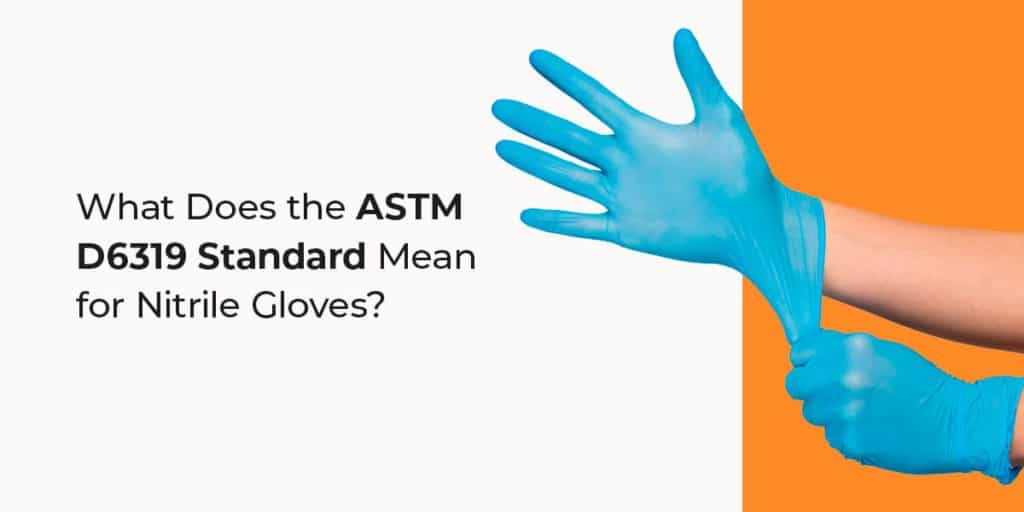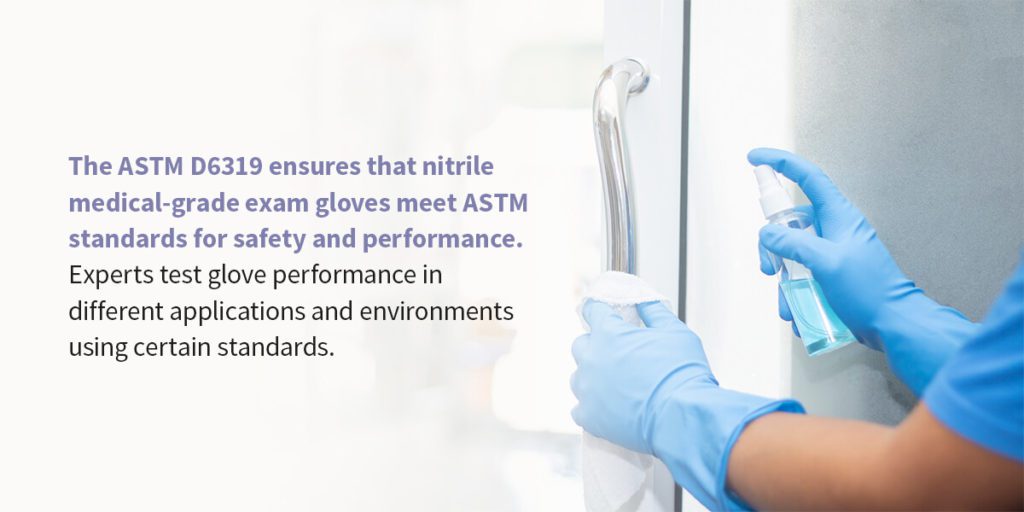
What Does the ASTM D6319 Standard Mean for Nitrile Gloves?
Nitrile gloves are a type of personal protective equipment (PPE) healthcare professionals use to safely perform tasks in medical settings. Nitrile medical-grade exam gloves provide protection from biological hazards such as chemicals and blood pathogens. Healthcare professionals use them during medical procedures to prevent germs and infections.
Nitrile rubber is also known as Buna-N, and its physical properties and chemical resistance can vary based on composition. Nitrile gloves are highly durable, resistant to chemicals and chemotherapy drugs and are latex-free, but they must meet certain standards to provide adequate protection.
Nitrile exam glove specifications make sure gloves meet safety and performance standards. The ASTM D6319 standard specification evaluates nitrile exam gloves’ safety and performance for various uses, including medical examinations, therapeutic procedures and diagnostic tests.
What Are Medical-Grade Exam Gloves?
Medical-grade exam gloves are a type of PPE that protects medical professionals and patients from hazardous chemicals, blood pathogens and bodily fluids to prevent germs and infections. Healthcare professionals use medical-grade exam gloves in combination with other protective measures such as proper hand-washing and disposal procedures to minimize risks. By doing so, they can protect themselves and their patients from germs and infections.
Glove manufacturers can use powder-free nitrile, latex or vinyl to produce medical-grade exam gloves, but nitrile is generally preferred. Exam gloves were originally designed for non-surgical procedures, but healthcare professionals now use them for all medical purposes.
From medical research lab technicians to surgeons, all medical professionals use medical-grade exam gloves to complete tasks and procedures. Medical professionals must use medical-grade exam gloves for any tasks or procedures that involve the following:
- Wound care
- Needles
- Incisions
- Proximity to membranes
Exam gloves protect against biological hazards such as bodily fluids, viruses and chemicals. They are tested for the following characteristics:
- Durability
- Puncture resistance
- Tactile sensitivity
- Flexibility and comfort
- Type 1 allergic reaction risk
The Difference Between Exam-Grade and Industrial-Grade Gloves
Both medical-grade exam gloves and industrial-grade gloves provide excellent protection, but medical-grade gloves offer extra protection to meet safety standards for healthcare purposes. Industrial-grade gloves share most of the same characteristics as medical-grade exam gloves, but they fall slightly short of meeting the medical-grade standards. Industrial-grade gloves require United States Food and Drug Administration (FDA) approval, but they are not approved for healthcare settings.
Medical-grade exam gloves provide slightly more strength and protection than industrial-grade gloves. The FDA determines acceptable quality limits (AQL) for medical-grade exam gloves, and experts test and score glove quality using an AQL percentage. A lower AQL score indicates fewer defects, while a higher AQL score indicates more defects.
Medical-grade exam gloves require an AQL score of 2.5 or lower, and only a few gloves may have defects. Experts will mark gloves for industrial use only if the gloves fail the test and receive a higher AQL score. Medical-grade exam gloves typically cost more than industrial gloves because they offer more dexterity and protection.
Industrial-grade gloves provide protection against less hazardous bodily fluids and chemicals. While industrial-grade gloves do not offer adequate protection for medical procedures, they provide appropriate protection for professionals in the following fields:
- Housekeeping
- Caregiving
- Childcare
- Janitorial
- Food handling
- Beauty and hairdressing
- Auto repair

What Is ASTM D6319?
The ASTM D6319 ensures that nitrile medical-grade exam gloves meet ASTM standards for safety and performance. Experts test glove performance in different applications and environments using certain standards. The American Society for Testing and Materials (ASTM) developed certain glove standards so experts can determine which gloves have the required properties for certain applications.
The ASTM D6319 standard is used in medical procedures to test nitrile gloves. Experts use the ASTM D6319 standard to evaluate nitrile rubber examination gloves for safety and performance.
What Does ASTM D6319 Test For?
The ASTM D6319 standard tests nitrile medical-grade exam glove characteristics such as powder residue, powder limit, sterility, physical requirements and physical dimensions. Under the ASTM D6319, nitrile gloves must meet the following standards:
- Exam gloves labeled as sterile must meet sterility requirements.
- Gloves must be free of holes.
- The inner and outer glove surfaces must be free of talc.
- Gloves must be measured from the middle fingertip to the outer cuff edge, and the length must be recorded in millimeters.
- The palm width must be measured from the index finger base and the thumb base, and it must be recorded in millimeters.
- The glove’s minimum thickness must be recorded in millimeters.
- Gloves must meet designated tensile strength and ultimate elongation after aging or exposure to a 70 degrees Celsius temperature for 166 hours.
- Nitrile gloves must not exceed the maximum powder residue limit.
The FDA banned powdered exam gloves in 2017 because they present a significant risk to healthcare workers and patients, so all medical-grade nitrile exam gloves must be powder-free. Thicker gloves offer more protection than thinner gloves, but they offer less tactile sensitivity and comfort. Longer gloves offer more protection in areas of wider or unknown exposure or when there is a channeling risk.
Tensile strength refers to the amount of force that can be applied to a glove before it breaks. Healthcare professionals should look for exam gloves with higher tensile strength for more durability and protection. Ultimate elongation refers to a glove’s level of stretch, and healthcare professionals should look for gloves with a higher level of stretch to prevent breakage when the gloves are snagged or stressed during procedures.
All examiners must perform ASTM D6319 testing on finished products only, and they can only test sterile gloves after sterilization is complete. Examiners may apply approved lubricant to the gloves to test for absorbable dusting powder. If gloves meet nitrile glove standards and receive an AQL score of 2.5 or lower, they are FDA-approved for medical use.

Make Sure You Have the Right Gloves for the Job
Medical settings put healthcare professionals and patients at risk for infections, harmful chemical exposure, viruses and germ exposure. Medical staff often work with needles, surgical instruments, bodily fluids and chemicals, which puts them at risk for serious infections and other hazards. FDA-approved medical-grade exam gloves provide protection from these hazards to create a safer, healthier work environment.
Protect your medical staff and patients with high-quality medical-grade nitrile exam gloves. Make sure your healthcare facility’s gloves offer the best protection possible with the greatest durability, thickness, tactile sensitivity and elongation. The ASTM D6319 standard specification tests nitrile medical-grade exam gloves to ensure they meet physical standards of safety and performance.
Prevent germs and infections with high-quality nitrile gloves from Sunline Supply. We only carry the highest-rated PPE products. With 24/7 sales availability, you can order products any time, and we will ship them to you quickly. Contact Sunline Supply to learn more about how we can provide your healthcare facility with ultimate protection from biological hazards.

